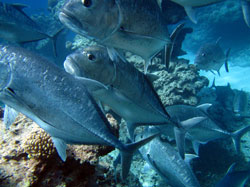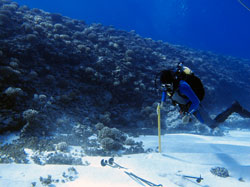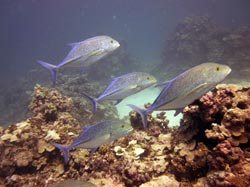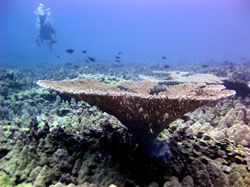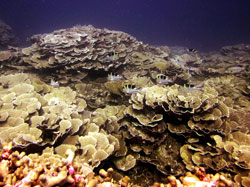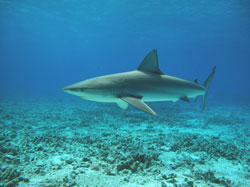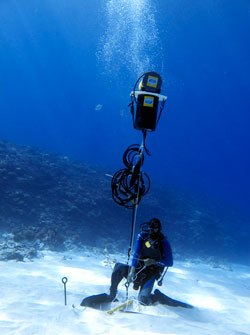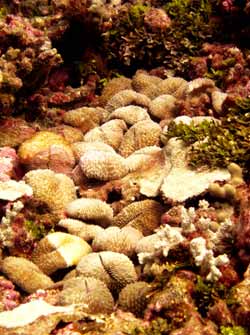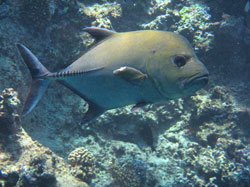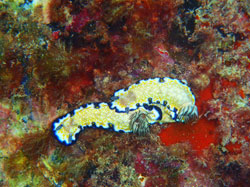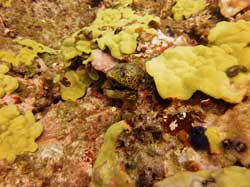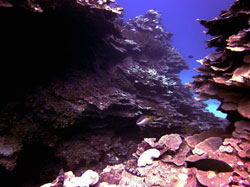
Researchers Return from 24-Day Expedition to Papahānaumokuākea Marine National Monument
On August 24, 2012, the Reef Assessment and Monitoring Program (RAMP) returned to Ford Island aboard the NOAA Ship Hiʻialakai, signaling the end of a 24-day research expedition to Papahānaumokuākea Marine National Monument (PMNM) in the Northwestern Hawaiian Islands (NWHI). This special place is not only the largest protected area in the United States and one of the largest in the world, but also one of the planet's last apex predator-dominated ecosystems, its waters teeming with large schools of sharks and reef fish.
Scientists from NOAA's National Marine Sanctuary Program and NOAA Fisheries, the University of Hawaiʻi and Scripps Research Institute visited French Frigate Shoals, Lisianski Island, Pearl and Hermes Reef and Kure Atoll to conduct various activities, including: rapid ecological assessments (REA) of reef fish, corals, other invertebrates and algae; coral disease surveys to determine disease presence in the NWHI; a bioerosion study to determine the growth and erosion of corals in the NWHI; and ecological acoustics research using underwater recording equipment.
Rapid ecological assessments have been conducted in the NWHI since 2000. Long-term monitoring of the abundance and distributions of reef fish, invertebrates, coral and algae are used to evaluate the status and trends of the health of these remote coral reef ecosystems. These activities improve our understanding of the region's marine systems and help us better manage the Monument.
This year, the team conducted 138 reef surveys across the four islands visited, recording no large coral or fish disease outbreaks, and no observations of any coral bleaching events. Two alien species were sighted at Lisianski Island – a feather duster worm commonly found in the main Hawaiian Islands and a bryozoan (a lace-like colonial animal), both of which have been recorded in the Monument but were previously unrecorded at Lisianski. Researchers also compiled data for a bioerosion study on corals that will help managers learn more about climate change and ocean acidification in the region.
An acoustics team deployed and retrieved several acoustic recorders throughout the Monument and found that the biological sounds made by coral reef organisms are much louder at night – at least double the intensity. The sounds were also found to generally be louder in areas where coral cover is greater, meaning that researchers and managers can potentially use passive recordings to estimate the state of a coral reef.
Regular encounters with predatory species such as sharks and ulua are common in the NWHI as compared to the Main Hawaiian Islands. The team saw many schools of large ulua and sharks, including gray reef sharks, white tip reef sharks, Galapagos sharks, and one tiger shark.
Staff from PMNM and the Centers for Ocean Sciences Education Excellence (COSEE) Island Earth program conducted ship-to-classroom 'ask a scientist' sessions via email with ten public and charter schools throughout the state. These schools will be treated to follow up visits by one of the scientists upon conclusion of the expedition. COSEE staff also documented research activities to produce education materials and arranged two live broadcasts from the ship on the radio program Hawaiʻi's Tomorrow on 760 AM.
All of these activities focus on the importance of marine sciences, the unique ecosystems in the Northwestern Hawaiian Islands, and the research conducted on the expedition.
Click here to view the press release.
Click here to view the 2012 RAMP expedition log and scientist profiles.
